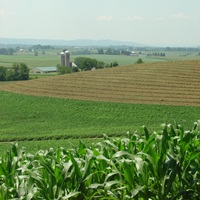
Local farmer, Renee Ciulla, wrote recently about how several New Hampshire farms used easements to ensure the possibility of continued agricultural production for future generations. Featured farms include Coppal House Farm, Good Earth Farm, Velvet Pastures Elk Ranch, Warren Farm, and Amber Acres. From Rodale Institute:
Green rolls of open hills dotted with lines of solid, red silos and white grazing sheep appeal to and please even those who aren’t passionate about farming themselves. In reality though, development is encroaching heavily and swiftly across the U.S., luring land owners with large bundles of cash. One effective way to prevent this development is by placing land in an agricultural or conservation easement. This voluntary agreement allows a landowner to limit the type or amount of development on their property while retaining private ownership. Furthermore, it ensures open space and possibly agricultural production forever. In general, farmers and conservation groups determine unique features about a particular parcel of land such as places that are suitable for buildings based on the size and configuration of the land, or places that should never be cultivated, such as areas close to a waterway. Decisions depend not only on the current farm plan, but also on potential farming plans of future generations.
In the case of John Hutton, owner of Coppal House Farm in Lee, New Hampshire, the lack of a conservation easement on his leased land meant a sudden suspension of his livelihood. Hutton and his family had leased the land in Stratham, NH for 25 years. Hutton held a year-to-year lease and was told, “As long as you plant a crop you can be here to harvest it.” John learned one winter after his harvest that the owners had decided to sell the land to a golf course developer.
“Almost 500 acres were for the golf course and several housing developments,” says Hutton. Not one to dwell on the negative, John and his wife picked up their life and worked tirelessly to start anew on a purchased piece of farmland. The owners were never interested in an easement, but John believes if they had been offered a tax break they might have been. These days Hutton feels that farmers are smartly negotiating for longer-term leases, but in the past it was common for year-to-year. It is still not unusual for beginning farmers to enter into these shorter-term arrangements. Coppal House Farm is a remarkable reminder of how land placed in conservation not only preserves land for lands sake, but for the continuance of a farmer’s livelihood. Read more…
